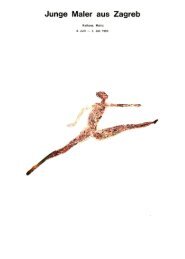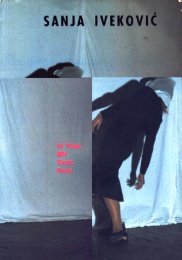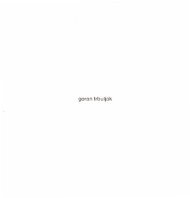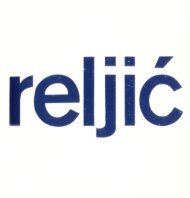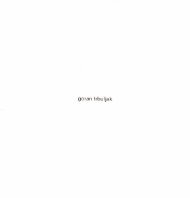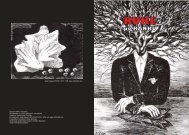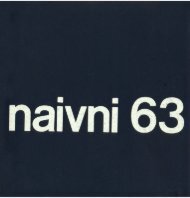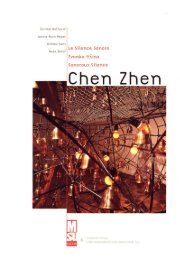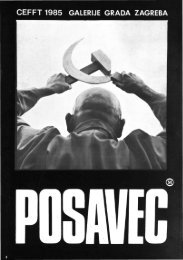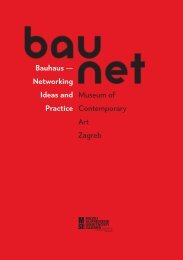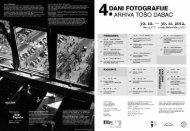The New Art Practice in Yugoslavia, 1966-1978
The New Art Practice in Yugoslavia, 1966-1978
The New Art Practice in Yugoslavia, 1966-1978
- TAGS
- practice
- yugoslavia
- www.msu.hr
Create successful ePaper yourself
Turn your PDF publications into a flip-book with our unique Google optimized e-Paper software.
preoccupation. He set out his attitudes on his post-conceptualist<br />
activities <strong>in</strong> a short text published <strong>in</strong> the catalogue for the<br />
exhibition "Spans 73" <strong>in</strong> the Gallery of Contemporary <strong>Art</strong> <strong>in</strong><br />
Zagreb: "<strong>The</strong>re is no crisis <strong>in</strong> art. <strong>Art</strong> does not exist beyond<br />
the artist. <strong>The</strong>re is a crisis with<strong>in</strong> artists. If we sit and talk,<br />
and everyth<strong>in</strong>g centres around the fact that most of what we<br />
manage to see of the "unambitious" (ambitious) art does not<br />
appeal to us, then my artist friends and myself we can say:<br />
crisis <strong>in</strong> art ... the artist confronted with a crisis, especially it<br />
he has theorized and produced non-obligatory objects d'art,<br />
can 1) absta<strong>in</strong>, 2) f<strong>in</strong>ally realize art as a way of life, 3) try to<br />
anticipate the emergence of a new trend which he will adopt,<br />
while until then he represented an artist-ludens and clung to old<br />
ideas. My own attitude is that given under no. 3). February<br />
1973.<br />
As members of the group KOD we thought of sett<strong>in</strong>g up a<br />
commune and when <strong>in</strong> 1971 we became group (3 KOD and<br />
even later when the groups were no longer <strong>in</strong> existence, we<br />
tried to put this <strong>in</strong>to practice. <strong>The</strong> commune was realized by<br />
Boiidar Mandi, who considers himself a disciple of KOD, who<br />
collaborated with us, worked with Vladimir Mandi and did<br />
<strong>in</strong>dependent work (actions, books, films).<br />
<strong>The</strong> Commune is situated on Mount Rudnik, <strong>in</strong> the village of<br />
Brezovica and is called "Clear Brook".<br />
P. S.<br />
When I accepted to write a text for the present publication on<br />
the work of the groups KOD, (3, (.3 KOD and other artists <strong>in</strong><br />
Novi Sad, we organized a few meet<strong>in</strong>gs to talk about <strong>in</strong>dividual<br />
and jo<strong>in</strong>t attitudes on this type of exhibition and publication.'<br />
S. Tima, M. Mandi and C. Dra were opposed to any k<strong>in</strong>d of<br />
of participation <strong>in</strong> the exhibition, they thought a different form<br />
of participation should be found: Slavko Bogdanovi and myself<br />
were <strong>in</strong> favour of tak<strong>in</strong>g part <strong>in</strong> the exhibition, and this view<br />
was also held by P. Vraneevi. V. Kopicl proposed a thorough,<br />
serious approach that would adequately represent our activities.<br />
C. Dra, M. Mandi, S. Tima, S. Bogdanovi and myself agreed<br />
that <strong>in</strong>stead of the text and documents on our work we should<br />
send a recorded tape of our last conversation, and <strong>in</strong>stead of<br />
the works themselves, as a k<strong>in</strong>d of documentation, we thought<br />
we should repeat <strong>in</strong> a different way some of the works and<br />
actions (Mandi for <strong>in</strong>stance suggested that a luncheon be<br />
organized <strong>in</strong> the gallery dur<strong>in</strong>g the exhibition). Another idea,<br />
which we also discussed later, concerned <strong>in</strong>visible art. Elements<br />
of this idea were already present <strong>in</strong> the work of M. Mandi<br />
which was not realized <strong>in</strong> Polia No. 156 (two blank sheets) and<br />
which s<strong>in</strong>ce it was not realized cont<strong>in</strong>ued to exist as an<br />
<strong>in</strong>visible work.<br />
S<strong>in</strong>ce there was no global attitude shared by all members, it<br />
rema<strong>in</strong>ed for me to write the k<strong>in</strong>d of text I had anticipated<br />
when I was first asked to do it.<br />
I hope that an important part of the text was taken up by<br />
<strong>in</strong>visible art.<br />
46<br />
<strong>The</strong> exhibition «<strong>The</strong> <strong>New</strong> <strong>Art</strong> <strong>Practice</strong>« at the Gallery of Contemporary<br />
<strong>Art</strong>. Zagreb <strong>1978</strong>.<br />
GROUP (.3<br />
Like the members of the group KOD, the future members of the<br />
group (3 also studied literature at the <strong>Art</strong>s Faculty <strong>in</strong> Novi Sad<br />
and wrote poetry. <strong>The</strong> study of l<strong>in</strong>guistics <strong>in</strong> the first year<br />
covered problems of language and l<strong>in</strong>guistic schools, with<br />
particular emphasis on de Saussure's structural l<strong>in</strong>guistics,<br />
semantics and semiology. <strong>The</strong> <strong>in</strong>formation theory was the<br />
l<strong>in</strong>k<strong>in</strong>g element between l<strong>in</strong>guistics and the problems of<br />
language, on the one hand, and art, especially some of the<br />
most recent trends <strong>in</strong> art (i. e. visual and concrete poetry, new<br />
media), on the other hand. Thus, some of the first <strong>in</strong>dividual<br />
works of the future members of the group, works which meant a<br />
break with the traditional practice, actually developed <strong>in</strong> the<br />
sphere of visual and concrete poetry and were based on some<br />
of the pr<strong>in</strong>ciples of the <strong>in</strong>formation theory, the ludic element<br />
play<strong>in</strong>g an important part. <strong>The</strong> first jo<strong>in</strong>t works by Ana Rakovi<br />
and Cedo Dra were no doubt <strong>in</strong>fluenced by Ana's study of<br />
mathematical logic and the set-theory, as well as her one-year<br />
study of physical chemistry before she took up the study of<br />
literature. Vladimir Kopicl was <strong>in</strong>terested <strong>in</strong> visual poetry, the<br />
American avantgarde, Cage and they studied Wittgenste<strong>in</strong><br />
together.<br />
<strong>The</strong> future members of the group (3 (Ana Rakovi. Cedomir<br />
Dra, Vladimir Kopicl and Mia 2ivanovi) studied with<br />
Miroslav Mandi, who was a member of the group KOD. <strong>The</strong><br />
regular Sunday meet<strong>in</strong>gs held dur<strong>in</strong>g the autumn of 1970 were<br />
first attended by Rakovi, Dra, Zivanovi and Mandi and<br />
later by Kopicl: the discussions covered previously agreed<br />
topics on the problems of art. <strong>The</strong> first works which transcended<br />
the traditional art limits were soon to be carried out.<br />
<strong>The</strong> first work by Kopicl was Basic Essay a critical,<br />
apologetic review of Slobodan Tima's Square. Amy Gold<strong>in</strong>g's<br />
words were quoted <strong>in</strong> the <strong>in</strong>troduction: "... a critic attempts,<br />
often at all costs, to <strong>in</strong>terpret a work of art "through itself", i. e.<br />
he strives to diagnose the extent to which the artist makes use<br />
of the possibilities of the media." This is followed by a complete<br />
statistical analysis of Square, and the last part of the work<br />
conta<strong>in</strong>s Regulations for the reader of "Basic Essay", <strong>in</strong> which<br />
relations between creator-work-critique-critic-consumer are<br />
analysed. <strong>The</strong> essay as a whole has thus become a work of<br />
art with its own logic, which already anticipates Kopicl's later<br />
analitical, textual works. Before the group (3 was founded and<br />
colectiv-e work undertaken, Kopicl produced a number of works<br />
which represented a transition from visual poetry to conceptual<br />
art. In one of the works, words and clipp<strong>in</strong>gs from an English<br />
Dictionary for children were used: another one consisted of a<br />
certa<strong>in</strong> number of small squares form<strong>in</strong>g a regular surface and<br />
on each one words were written out which could be comb<strong>in</strong>ed<br />
and brought <strong>in</strong>to different relations.<br />
Dur<strong>in</strong>g this same period Mia Zivanovi produced his first work<br />
Non-Semantic Field (Fig. 188,) <strong>in</strong> which the different forms of<br />
non-semantic fields, by be<strong>in</strong>g commented upon separately and<br />
<strong>in</strong>cluded <strong>in</strong> the work as a whole, became the carriers of its<br />
mean<strong>in</strong>g. 2ivanovi never actually realized a work jo<strong>in</strong>tly with<br />
the other members of the group, thus he was only briefly and<br />
formally a member of the group.<br />
Ana Rakovi and Cedomir Dra worked together from the start,<br />
and their first works were based on the set-theory. A red circle<br />
was given with three ways of conceiv<strong>in</strong>g its position and relation<br />
<strong>in</strong> space (the gallery). A certa<strong>in</strong> number of table-tennis balls<br />
were arranged <strong>in</strong> such a way as to form a rectangle, the balls<br />
had letters written on them and beside the work there were<br />
read<strong>in</strong>g <strong>in</strong>structions (accord<strong>in</strong>g to the set-theory). <strong>The</strong> work<br />
Sight Entropy was realized <strong>in</strong> a similar way, lay<strong>in</strong>g out the<br />
possible effects which could be produced by circles.<br />
Collaboration was soon established between these artists and<br />
the group KOD, followed by the first jo<strong>in</strong>t appearances <strong>in</strong> Novi<br />
Sad and Belgrade (January and February 1971).<br />
<strong>The</strong> group (a was founded at the end of February (the same<br />
even<strong>in</strong>g when the decision was made that KOD would no<br />
longer exist as a group), some time before the exhibition<br />
"Examples of Conceptual <strong>Art</strong> <strong>in</strong> <strong>Yugoslavia</strong>". Works produced<br />
until then as a result of <strong>in</strong>dividual endeavour were presented<br />
at the exhibition. 2ivanovi was a member of the group only<br />
dur<strong>in</strong>g the exhibition, so that jo<strong>in</strong>t activities were later pursued<br />
by Dra, Kopirl and Rakovi.<br />
As group (.3 they worked together until May 1971, when a new<br />
group, (3 KOD was founded. Dur<strong>in</strong>g this time Kopicl, Rakovi<br />
and Dra realized several jo<strong>in</strong>t works immanently marked by a



